How Big Data Studies Challenge Well-Known SEO Facts
How Big Data Studies Challenge Well-Known SEO Facts
SEO has a lot of unclear aspects, but one thing is for sure – there’s no shortage of practical guides online. Type in an “ultimate SEO guide,” and Google will return you tons of them. Big names in SEO share their tactics and suggestions that small bloggers rewrite afterwards. Eventually, that information goes viral as the absolute truth across the web.
Although that info isn’t always backed up with facts and figures, many people blindly trust it. However, big studies prove some SEO axioms wrong once in a while. Having processed millions of SEO data items, guys from Ahrefs found contradictions in various topics – on-page optimization, long-tail keywords, featured snippets, etc.
Learn which of the well-known SEO facts didn’t prove out as a result of large-scale research.
1. Your target keyword must be in all the “strategiс” places on the page.
There seems to be a conspiracy among authors of on-page SEO guides. They recommend adding a target keyword wherever possible – URL, SEO title, heading, subheadings, etc. However, the analysis of 2 million keywords proves most of the Top 10 pages lack it in those “strategic” places. And they still rank high in organic search. Let’s take a closer look at each case.
Keyword in URL
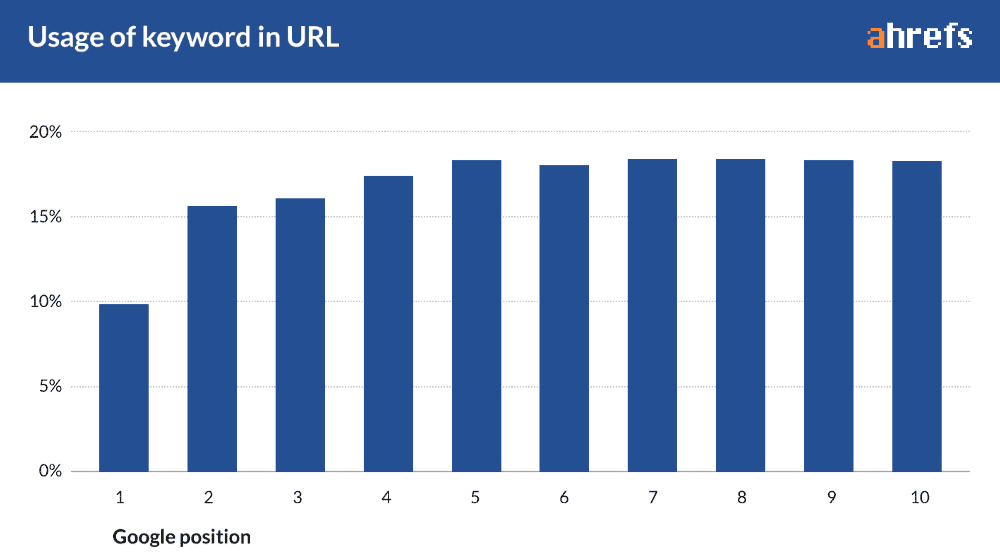
How Big Data Studies Challenge Well-Known SEO Facts
SEO has a lot of unclear aspects, but one thing is for sure – there’s no shortage of practical guides online. Type in an “ultimate SEO guide,” and Google will return you tons of them. Big names in SEO share their tactics and suggestions that small bloggers rewrite afterwards. Eventually, that information goes viral as the absolute truth across the web.
Although that info isn’t always backed up with facts and figures, many people blindly trust it. However, big studies prove some SEO axioms wrong once in a while. Having processed millions of SEO data items, guys from Ahrefs found contradictions in various topics – on-page optimization, long-tail keywords, featured snippets, etc.
Learn which of the well-known SEO facts didn’t prove out as a result of large-scale research.
1. Your target keyword must be in all the “strategiс” places on the page.
There seems to be a conspiracy among authors of on-page SEO guides. They recommend adding a target keyword wherever possible – URL, SEO title, heading, subheadings, etc. However, the analysis of 2 million keywords proves most of the Top 10 pages lack it in those “strategic” places. And they still rank high in organic search. Let’s take a closer look at each case.
Keyword in URL

As shown on the graph, only less than 20% of the Top 10 pages have a target keyword in URL. The remaining 80% got to the top without it. Does it mean you should remove keywords from URLs and use some jumbled text like this mywebsitedomain.com/?product_id=7395Jk? Definitely not. First of all, a keyword in URL matters for readers, allowing them to figure out what your page is about at once. But it’s not something that could help you with rankings.
Keyword in SEO Title
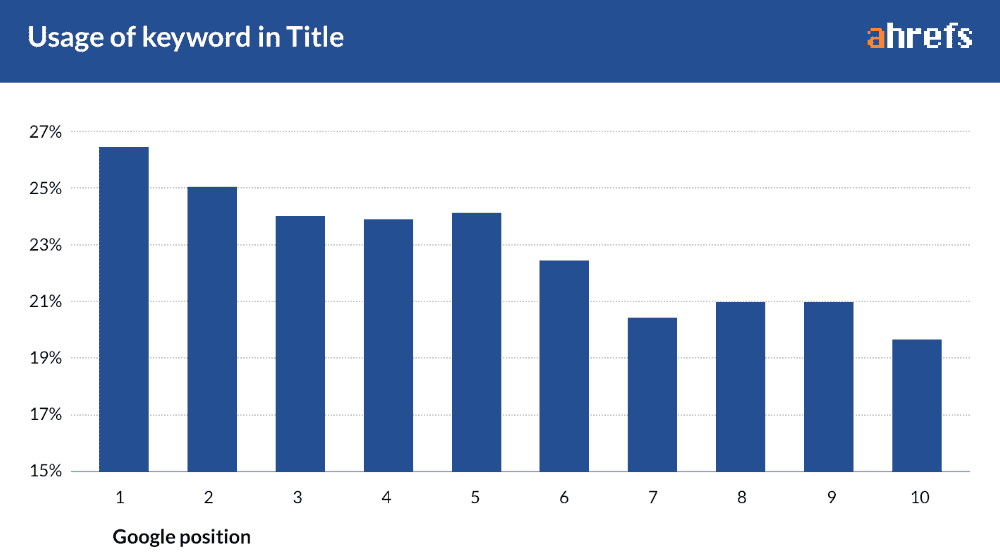
Google seems to devalue a target keyword in the SEO title. Only 27% of the Top 10 pages contain it, while the rest rank high with no keyword there. Treat it as an opportunity to craft catchy titles without having to stay within any verbal limits. That way, more people will be thrilled to click on your page in SERP. And a click-through rate is what Google analyzes to understand if your content deserves the top position.
Keyword in Headline
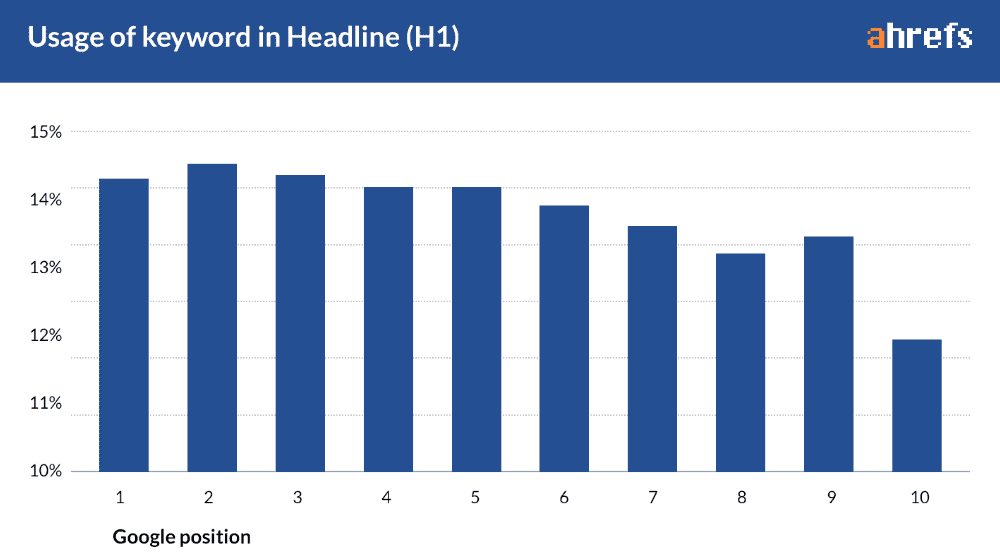
The headline (or H1 tag) is another “strategic” place that often goes without a target keyword. As you can see, 85% of the Top 10 pages lack it there. Moreover, 70% of all the pages analyzed don’t have an H1 tag at all. Although the headline won’t help you with a ranking boost directly, it’ll still work in your favor. Its wording can influence how people will link to your content. If there’s a target keyword, most likely they’ll add it to the anchor text of a backlink, which correlates with higher rankings (more on this in Section #5).
Keyword in Subheading (or H2 tag)
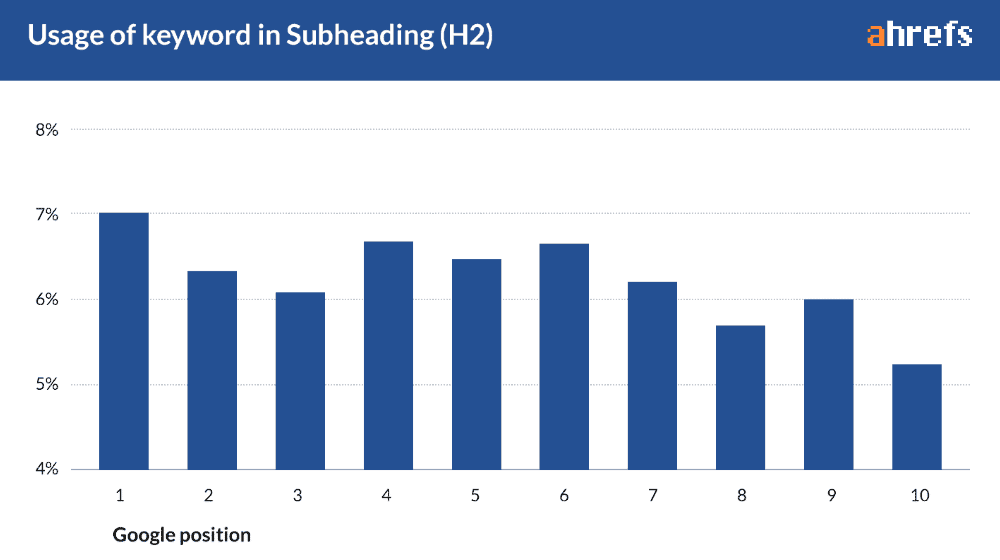
In 93% of cases, there’s no target keyword in H2 tags on the Top 10 pages. The bottom line is to write meaningful subheadings without bothering about wording. That way, your content will look natural and oriented at real people rather than Googlebot. Even if you find ways to stuff keywords into subheadings naturally, your ingenuity won’t pay off in terms of ranking.
Keyword in Meta Description
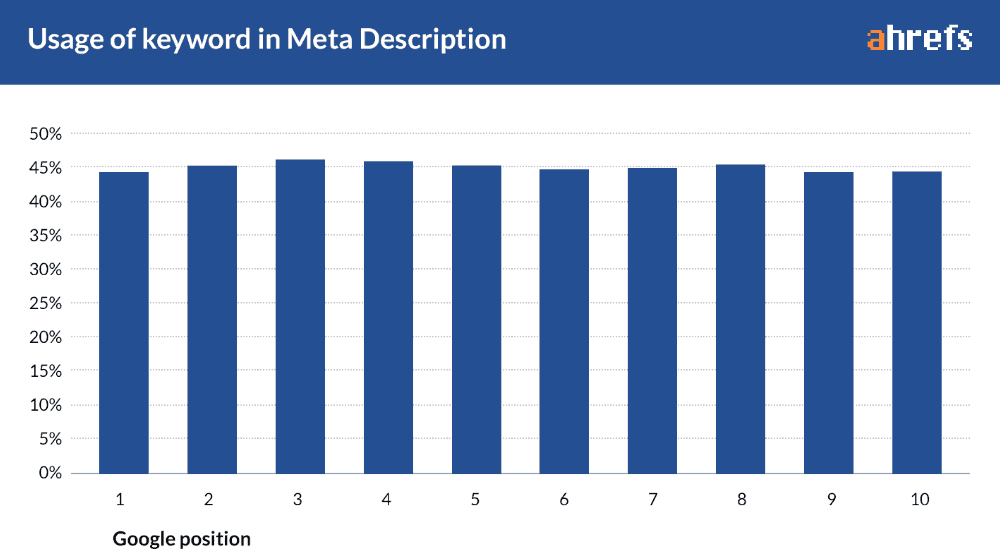
As in the case with H1 tags, over 70% of the Top 10 pages have no meta description. As for the pages that contain it, a target keyword is missing in more than half of them. While you’re still recommended to fill in a meta description field, it won’t increase your chances of ranking on the first page in SERP. Today, Google often omits meta descriptions and extracts a portion of text that is the most relevant to the search query.
2. HTTPS sites rank higher than HTTP sites.
Google is a big fan of cybersecurity. No surprise the company confirmed HTTPS as a ranking signal on its official blog. What’s surprising is that over 85% of the pages analyzed have no HTTPS protection, but they are still in the top 10. By no means, this finding suggests you should neglect HTTPS, especially if you deal with sensitive data like customers’ credit cards. Just use it for its intended purpose, which is security rather than a ranking boost.
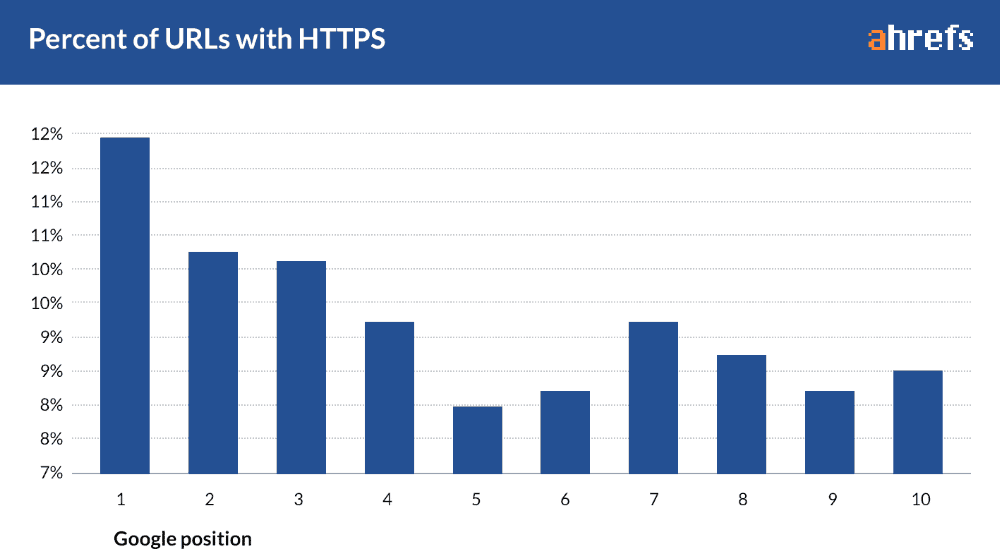
3. Long-tail keywords are necessarily long.
Most sources define “long-tail keywords” as phrases containing at least three words. But the length isn’t what makes a keyword long-tail. First of all, it’s low search volume per month. According to the research of 1.4 billion keywords, one- and two-word phrases can have miserable search volume as well. And vice versa. Phrases containing more than three words can get a lot of monthly searches.
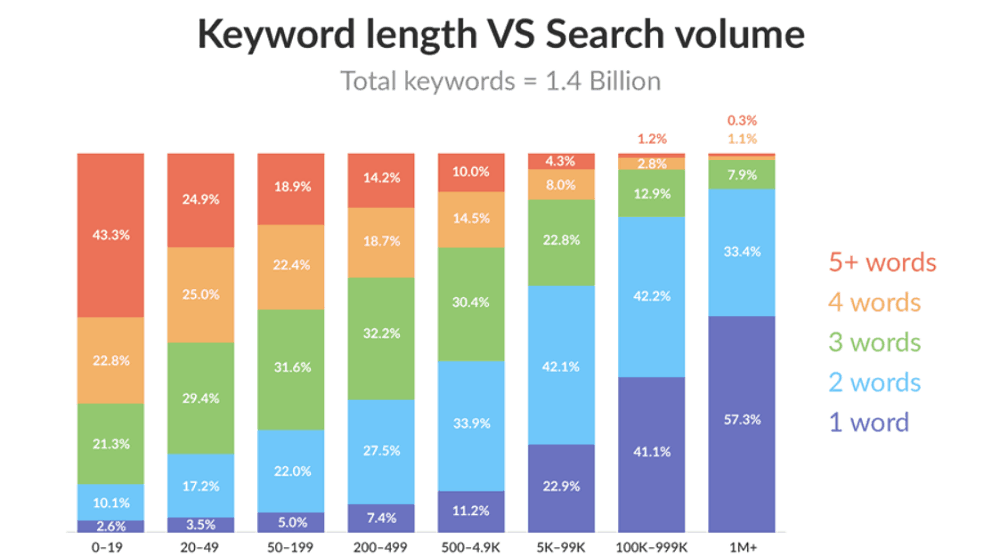
- 12.7% of short queries (one and two words) get 0-19 monthly searches.
- 34.8% of longer queries (three, four, and five words) get 1+ million monthly searches.
For example, let’s take Four Seasons and Centrum Hotel. Both queries contain two words, but there is a big difference between their search volumes. Four Seasons is a popular five-star hotel in New York, so it gets 107K searches per month.

Centrum Hotel is a little-known hotel on the island of Cyprus, so its volume is miserable – only 20 monthly searches.

You can check this tendency yourself using your keyword generator. Type in your target query and filter results by search volume and word count.
4. Lengthy content of 2,000+ words holds the top position.
There’s been a lot of buzz that long-form content of 2,000+ words is your ticket to the top. But pages ranking #1 contain around 800 words on average. As in the case of long-tail keywords, long-form content is not about the length. In the era of Hummingbird, Google wants to give detailed answers to users’ queries. But idle talk for almost 2,000 words isn’t a detailed answer. You can be concise in your writing but still go into details. When you create a new piece of content, try to provide more value with fewer words.
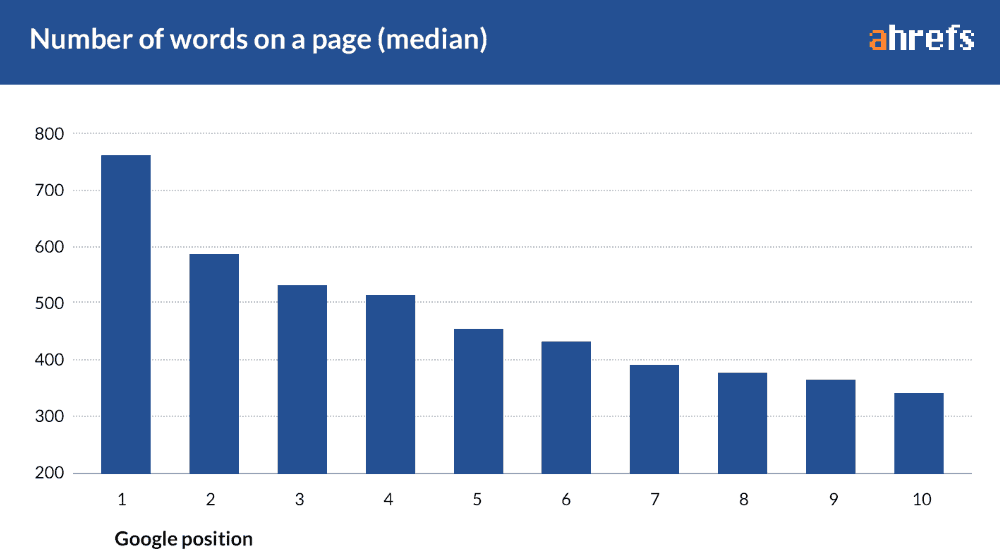
5. Keyword-rich anchors always lead to penalties.
There are many scary tales in the SEO community that keyword-rich anchors will push you out of organic search. While Google Penguin does penalize abusers, it doesn’t mean you can’t use anchors at all. Here’s what the analysis of 320,000 pages proves. The closer the page is to the top, the more exact- and partial-match keyword anchors it has.
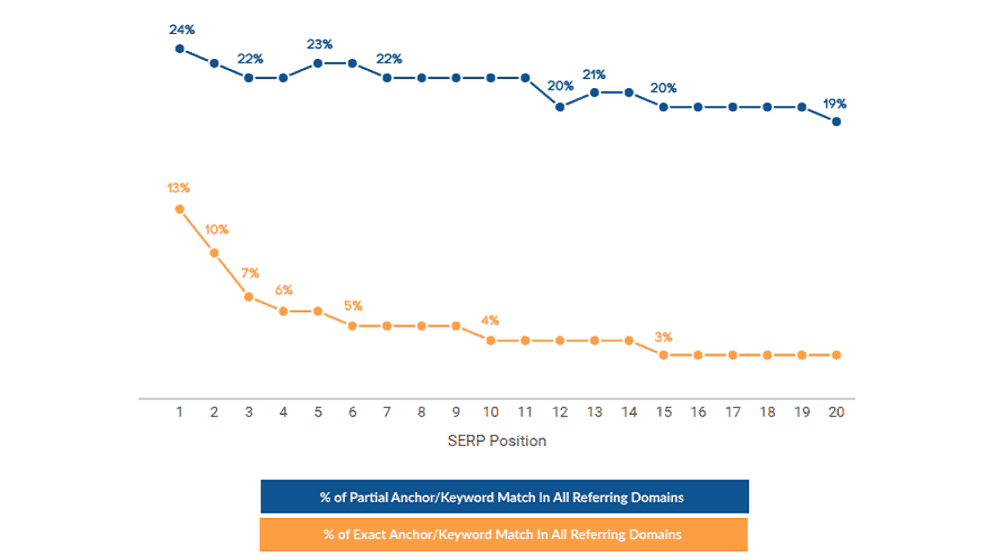
The bottom line is to keep balance between different anchor types. To avoid penalties, limit exact-match keyword anchors to 2% and partial-match keyword anchors to 30%. What about the rest? Feel free to use branded, natural, and other types of anchors.
6. Featured snippets bring more page visits than organic results.
As featured snippets hold a privileged position above the Top 10 results, logic says they should get more traffic than pages ranking #1. However, the study of 2 million featured snippets found no proof to this. What’s the reason? Users may sniff out some sort of manipulation, as in the case with paid ads, and just scroll down to organic results.
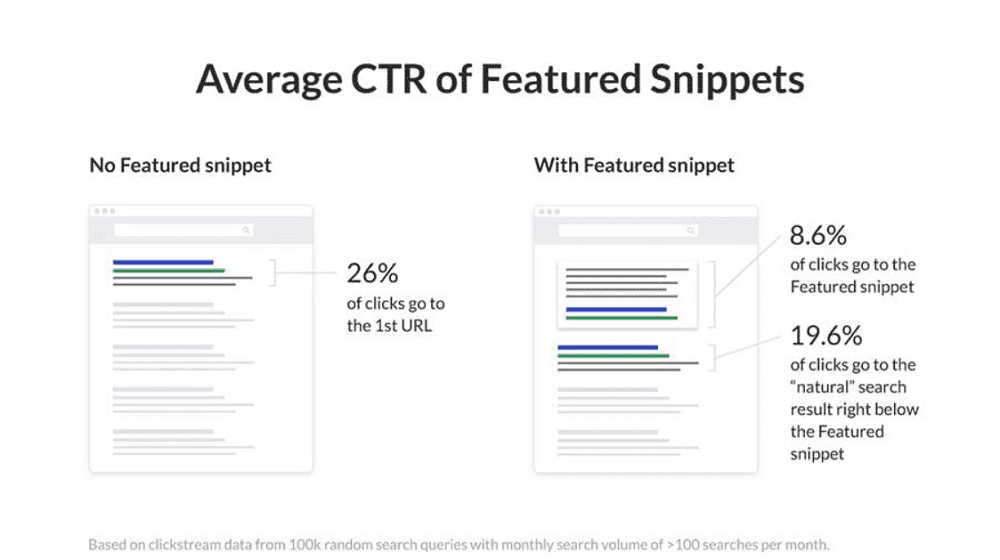
7. Question-based queries trigger most featured snippets.
Having analyzed 1.4 million featured snippets, A.J. Ghergich created a breakdown of questions, prepositions, and comparisons that trigger most of the snippets. However, Ahrefs’ study shows the vast majority of them show up for queries that don’t belong to any of those popular groups.
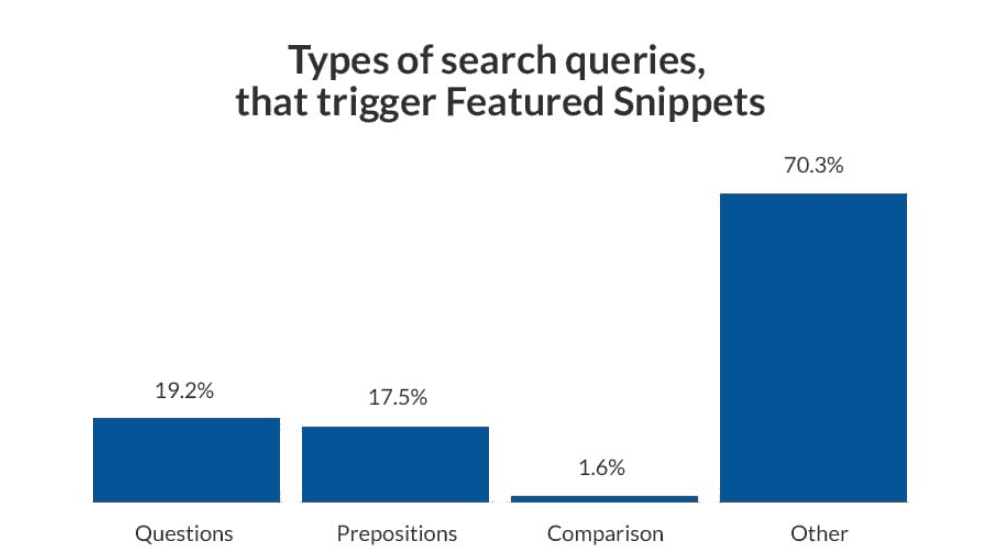
Wrap-up
It’s up to you whether to agree or disagree with these findings, but data is data. Also, note that they are based on correlation rather than causation. For example, an 800-word post ranks #1 not because of its word count. Many other factors keep it at the very top of SERP, e.g. well-chosen keywords and strong backlink profiles. Have you ever noticed any other controversies in SEO? Share them with us in the comments, please.
About the Author
Nick Campbell is a content marketer and outreach manager at Ahrefs. He is passionate about technology, SEO, case studies, and blogging trends. When Nick is not researching a new topic, he’s probably at some high-tech event.




